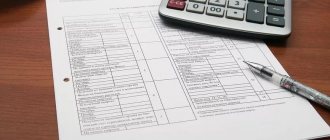Property tax calculations.
To record calculations for corporate property tax, account 0 303 12 000 is used.
The procedure for calculating, withholding and paying this tax is established by Ch. 30 Tax Code of the Russian Federation.
According to paragraph 1 of Art. 374 of the Tax Code of the Russian Federation, objects of taxation for Russian organizations are recognized as real estate (including those transferred for temporary possession, use, disposal, trust management, contributed to joint activities or received under a concession agreement), accounted for on the balance sheet as fixed assets in the manner established for accounting purposes.
The criteria for classifying the property of state (municipal) institutions as fixed assets are defined in clauses 7, 8 of the Federal Budgetary Accounting Standards “Fixed Assets”[3].
When classifying fixed assets as movable or immovable property for tax purposes, one should take into account the recommendations from letters of the Federal Tax Service of the Russian Federation dated 08.28.2019 No. BS-4-21/ [email protected] , dated 07.30.2019 No. BS-4-21/14997, dated 05.04 .2019 No. BS-4-21/6262, dated 03/25/2019 No. BS-4-21/ [email protected] , Ministry of Finance of the Russian Federation dated 07/09/2019 No. 03-05-05-01/50498, dated 07/03/2019 No. 03 -05-05-01/48946.
The calculation of the amount of tax on property held by institutions with the right of operational management is carried out according to general rules - based on the residual value of real estate objects (clause 1, 3 of Article 375 of the Tax Code of the Russian Federation, letter of the Ministry of Finance of the Russian Federation dated April 3, 2019 No. 03-05- 05-01/22907, dated 02/25/2019 No. 03-05-04-01/11984, dated 12/13/2017 No. 03-05-05-01/83122).
The tax base for real estate taken into account by public sector organizations as fixed assets is formed until the disposal of such property (Letter of the Federal Tax Service of the Russian Federation dated April 30, 2019 No. BS-4-21 / [email protected] ).
For individual organizations Art. 381 of the Tax Code of the Russian Federation establishes property tax benefits. They may also be provided for by the laws of the constituent entities of the Russian Federation.
The rate, procedure and terms of payment of property tax for organizations are approved by the laws of the constituent entities of the Russian Federation. In this case, the tax rate cannot exceed 2.2% (clause 1 of Article 380 of the Tax Code of the Russian Federation).
The tax amount is calculated based on the results of the calendar year. At the same time, based on the results of each quarter, organizations calculate advance tax payments (if such payments are provided for by the laws of the constituent entities of the Russian Federation). The timing and procedure for paying taxes (advance payments) are also established at the regional level (clauses 1, 2, 4 of Article 382, clause 1 of Article 383 of the Tax Code of the Russian Federation).
Operations for accrual and transfer to the budget of calculated amounts of property tax (advance payments) are reflected in accounting (budget) accounting as follows:
| Contents of operation | State institutions | Budgetary (autonomous) institutions | ||
| Debit | Credit | Debit | Credit | |
| Property tax assessed | 1 401 20 291 1 109 xx* 291 | 1 303 12 731 | 0 401 20 291 0 109 xx 291 | 0 303 12 731 |
| Tax paid to the budget | 1 303 12 831 | 1 304 05 291 | 0 303 12 831 | 0 201 11 610 off-balance sheet account 18 (KVR 851 / subarticle 291 KOSGU) |
*Hereinafter: in the table, instead of the “xx” symbol, the corresponding analytical code is indicated.
At the end of 2021, a budgetary cultural institution assessed property tax in the amount of 13,000 rubles. The tax was paid through a subsidy for the performance of a government task. When calculating the volume of the subsidy, these costs are included in the cost of maintaining real estate.
In accordance with Instruction No. 174n[4], the following entries will be made in the institution’s records:
| Contents of operation | Debit | Credit | Amount, rub. |
| Property tax assessed (based on an accounting certificate with a tax return attached) | 4 401 20 291 | 4 303 12 731 | 13 000 |
| Tax transferred to the budget | 4 303 12 831 | 4 201 11 610 off-balance sheet account 18 (KVR 851 / subarticle 291 KOSGU) | 13 000 |
How is the organization's property reflected in accounting?
To briefly answer the question of what accounting for an organization’s property consists of, we can name three main positions that fall into this category:
- funds (cash and non-cash, in accounts and at the cash desk);
- tangible assets (fixed assets and low-value assets);
- intangible assets.
Each property item has its location on a specific balance sheet account. This localization depends on many factors. In particular, on the cost. That property whose value is less than 40,000 rubles, but whose period of use exceeds a calendar year, is called low-value. It is taken into account on accounts 10, 11 and 15. Capitalization is expressed by standard accounting entries D10-K60.
Those same assets that cannot be classified as low-value and which the organization considers its fixed assets have a number of distinctive characteristics:
- this property is used to create goods that will be subsequently sold, as well as to provide services (perform work);
- operation of such property is possible for a long period (more than a year);
- the book value of the property is more than 40,000 rubles.
Fixed assets are capitalized by posting:
Debit 08 – Credit 60 (Purchase from supplier and classification as fixed assets).
Next, the cost of fixed assets is written off to the debit of account 01.
Both fixed assets and low-value assets are classified as tangible assets. That is, objects that have their own material expression and are localized in space. They can be touched, seen, used. But there are also those assets that also have value and are capable of generating income for their owner, and often considerable income, but they do not have a tangible physical form. These assets are considered to be intangible. And these include:
- intellectual rights;
- rights to use natural resources;
- business reputation of the organization;
- organizational expenses.
Intangible assets do not have physical form, but are capable of bringing economic benefits to an enterprise.
How property tax will change in 2021
In 2021, several laws were adopted that affected the procedure for property taxation. Among the changes are the following:
- We updated the property tax declaration form - the new form must be used for reporting for 2021 (Order of the Federal Tax Service of Russia dated July 28, 2020 No. ED-7-21/). The new form takes into account coronavirus benefits, and also adds special arrangements for organizations that have entered into an agreement to protect and encourage investment.
- New codes for federal and regional benefits related to coronavirus have appeared.
- It no longer matters whether real estate is accounted for as a fixed asset; tax will still have to be paid unless the region decides otherwise.
- The list of real estate that is taxed at cadastral value has been increased. Now these are all objects that are subject to personal property tax. Residential premises, garages, parking spaces, unfinished construction projects, residential buildings, garden houses, utility buildings or structures on plots for personal households or individual housing construction were added to the old objects.
- Accountants no longer need to submit advance tax calculations; they have been canceled as of January 1, 2021.
- The tax return can be submitted centrally. If a taxpayer is registered simultaneously with several tax authorities at the location of his property, then he has the right to submit a declaration to one of the inspectorates of his choice.
How to keep records of the sources of an organization's property
Accounting for an organization's property implies identifying the sources of formation of such property. All sources can be divided into two main groups - own funds and attracted resources. Often, an enterprise acquires property through the use of its own capital. The organization creates equipment and, using funds from its sale, updates the machine park: it expands the list of fixed assets with the help of which it makes a profit in the future. But equity capital is not always enough for large-scale activities. It is especially difficult to implement a developed business plan at the initial stage, when there are very few such funds. Often, a company attracts resources by concluding loan agreements with credit institutions, as well as with business partners. From an accounting point of view, property formed from borrowed funds is also considered to be property acquired by an enterprise on the terms of deferred or installment payment. In other words, the counterparty credited the organization for the amount of the cost of material assets supplied and services provided.
It is extremely difficult to carry out business activities without using attracted financing. In truth, there are no organizations that operate without borrowed funds.
Read material on the topic: Accounting services for companies
Next, we will consider what equity and borrowed capital are and what they consist of.
Each enterprise has certain assets on its balance sheet. But it is not always fully paid for by the company. That is, part of the property, as we have already said, can be formed through borrowed funds. Therefore, the value of its liabilities should be subtracted from the value of the organization’s property, and then you will receive the net value of the property - that is, the enterprise’s equity capital. It consists of several parts:
- The authorized capital is formed at the stage of formation of the enterprise from the contributions of the founders. The percentage of these contributions and their amount are not specified by law; there is only a minimum limit for the authorized capital - 10,000 rubles. If the owners of the company do not raise this amount initially, then they will not be able to register the organization.
- Additional capital is the amount formed as a result of the additional valuation of non-current assets, which is periodically carried out as part of accounting for the organization’s property. In general, ways to generate additional capital can be: revaluation of fixed assets as a result of inflationary processes, which led to an increase in their value;
- the result of conversions into domestic currency of contributions from foreign owners to the company’s authorized capital, the result of the impact of exchange rate differences on the assessment of the value of the company’s property. The day of registration of the enterprise and the day of actual payment of the authorized capital do not always coincide. That is why, on the day of registration, the founder’s contribution was valued at one amount, and at the time of payment this amount could increase significantly due to changes in the exchange rate;
- the appearance of share premium of a joint-stock company in cases where the real value of the shares sold exceeds their nominal value. The opposite situation during the initial issue of shares is simply unacceptable. And selling at a price higher than the nominal price is a common thing.
- Credit debt is the organization's obligations to counterparties. This may be arrears for settlements with partners, or perhaps the obligation to distribute GDP.
Legislative framework
Payers of property tax are all legal entities that own taxable objects. Officials have provided for relaxations. So, for example, companies that have switched to special tax regimes are exempt from paying property tax (IP).
However, there are exceptions to this rule. Enterprises and organizations that apply special regimes are required to pay IP if they own special types of property. The list of these categories of fixed assets is approved by the legislative authorities of the constituent entities of the Russian Federation.
Since IP is a regional tax, the authorities of the subject have the right to approve reporting periods for fiscal payments. This means that taxpayers, in addition to the mandatory final payment (paid once a year based on the results of the tax period - year), can transfer advance payments to the budget.
You can find out what frequency of payments is established in your region in 2021 on the official website of the Federal Tax Service.
When calculating property tax, entries must be reflected in accounting and tax records. Moreover, the preparation of accounting records has its own characteristics. We'll talk about them further.
Payers
- Legal entities that have a taxable object by right of ownership, economic management or operational management on the territory of the Republic of Kazakhstan;
- Individual entrepreneurs who have a taxable property on the territory of the Republic of Kazakhstan;
- Concessionaire;
- Individuals who have a taxable object.
A structural unit may be recognized as a property tax payer for those objects that correspond to the location of the structural unit.
The following are not payers:
- Peasant or farm enterprises, legal entities producing agricultural products, aquaculture products (fish farming), whose taxable income is taxed at a rate of 10%, applying the generally established taxation procedure - for taxable objects used in the production, storage and processing of their own agricultural products;
- Government agencies;
- State enterprises of correctional institutions of the authorized state body in the field of execution of criminal penalties;
- Religious associations;
- Individuals:
- Conscripts for the period of military service (study);
- Heroes of the Soviet Union, mothers of many children, pensioners living separately and other categories specified in paragraphs. 1) clause 2 art. Tax Code of the Republic of Kazakhstan - within 1,000 times the MCI of the total cost of the objects;
- Participants of the Great Patriotic War and persons equivalent to them, disabled people of groups I and II - within 1,500 times the MCI of the total cost of the objects;
- Persons awarded orders and medals of the former USSR for selfless labor and impeccable military service in the rear during the Great Patriotic War and other categories specified in paragraphs. 2) clause 2 art. Tax Code of the Republic of Kazakhstan - within 1,500 times the MCI of the total cost of the objects;
- Orphans and children left without parental care - for the period until they reach the age of eighteen.
Features of calculation for cadastral valuation
In 2013, a law was adopted according to which, in the future, real estate will be valued at cadastral value. This process is gradual, but has already begun in 2014 in certain regions and for certain types of real estate (office, retail, etc.). But soon this procedure will be introduced throughout the Russian Federation.
The calculation procedure for this property tax is the same. However, there are features of the transition period. For example, if a cadastral valuation was carried out for the entire building, but the organization owns only part of it. To calculate the tax base, the accountant will first need to determine the share of ownership in the total area of the building (as a percentage or fraction - it doesn’t matter), and then multiply the result by the amount of the total cadastral value.
Benefits for paying property taxes in 2021
For some types of organizations, benefits are applied that exempt from paying property tax (see Article 381 of the Tax Code of the Russian Federation):
- the organization is part of a free economic zone, belongs to the religious sphere or the penal system;
- "Skolkovo", prosthetic and orthopedic enterprises, advocacy and legal consultations, state research centers, management companies of innovative scientific and technological centers;
- management companies, participants, residents of various economic zones;
- manufacturers of pharmaceutical products, public organizations of disabled people.
Also, some types of real estate are exempt from tax: federal public roads, used energy-efficient real estate, real estate for hydrocarbon production.
Regions can establish their own benefits, reduce rates and exempt from paying taxes (clause 2 of Article 372 of the Tax Code of the Russian Federation). In 2021, landlords who deferred rent payments to their tenants could receive additional benefits. The benefit is to reduce the amount of tax. Check the information on benefits and rates in your region on the official website of the tax service.
Due to the spread of COVID-19, a number of organizations have been exempted from paying taxes and advance payments for the period of real estate ownership from April 1 to June 30, 2021.
The system will calculate the tax and prepare a payment invoice
“Accounting is a convenient program. Thanks to the developers. I have been working with Kontur for a long time. And it’s convenient to manage personnel; you’ll never miss anything in payroll. Taxes are calculated on their own. All reports reach the recipient on time. Everything is updated with the times. I really like it, everything is convenient. And when something is unclear, you can call - and they will always come to your aid. Thanks again to the developers."
Natalia Abbasova, accountant, senior Veshenskaya, Rostov region.
How to calculate property taxes in 2021
The tax service calculates the tax for entrepreneurs and sends them a notice for payment. Organizations must calculate the tax themselves. In the accounting web service Kontur.Accounting, you can do this automatically.
- First you need to figure out which of your existing assets is subject to tax.
- Next, you should check whether the organization is entitled to benefits - data on benefits is contained in regional laws.
- Find out the basis for calculating tax.
- Find out the tax rates established in the region.
- Calculate the tax payable to the budget.
The basis for calculating property tax can be the average annual value of real estate or the cadastral value. Let's look at why this depends further.
The tax base
The basis for this type of budget payment should be considered the value of property, calculated on average for the year, and which has all the characteristics of a taxable object. Such property is accounted for at its residual value, reflected accordingly in the accounting records. This procedure for determining the base and the principle by which property tax is calculated must be enshrined in the accounting policy.
It may happen that for some types of fixed assets depreciation charges are not made. In such circumstances, the cost of objects will need to be calculated by subtracting from the original cost the amount of depreciation determined according to depreciation rates.
Tax rates
| Taxpayer category | Tax rate |
| 1. Legal entities | 1.5% to the tax base |
| 2. Legal entities applying the SNR on the basis of a simplified declaration 3. Individual entrepreneurs | 0.5% to the tax base |
4. Legal entities:
| 0.1% to the tax base |
| 5. Legal entities that are autonomous educational organizations | 0 % |
For individuals, property tax is calculated depending on the value of the property at the following rates:
| Number | Cost of taxable objects | Tax rate |
| 1. | up to 2,000,000 tenge inclusive | 0.05 percent of the value of taxable objects |
| 2. | over 2,000,000 tenge up to 4,000,000 tenge inclusive | 1,000 tenge + 0.08 percent on an amount exceeding 2,000,000 tenge |
| 3. | over 4,000,000 tenge up to 6,000,000 tenge inclusive | 2,600 tenge + 0.1 percent on an amount exceeding 4,000,000 tenge |
| 4. | over 6,000,000 tenge up to 8,000,000 tenge inclusive | 4,600 tenge + 0.15 percent on an amount exceeding 6,000,000 tenge |
| 5. | <“text-align: center;”> over 8,000,000 tenge up to 10,000,000 tenge inclusive | 7,600 tenge + 0.2 percent on an amount exceeding 8,000,000 tenge |
| 6. | over 10,000,000 tenge up to 12,000,000 tenge inclusive | 11,600 tenge + 0.25 percent on an amount exceeding 10,000,000 tenge |
| 7. | over 12,000,000 tenge up to 14,000,000 tenge inclusive | 16,600 tenge + 0.3 percent on an amount exceeding 12,000,000 tenge |
| 8. | over 14,000,000 tenge up to 16,000,000 tenge inclusive | 22,600 tenge + 0.35 percent on an amount exceeding 14,000,000 tenge |
| 9. | over 16,000,000 tenge up to 18,000,000 tenge inclusive | 29,600 tenge + 0.4 percent on an amount exceeding 16,000,000 tenge |
| 10. | over 18,000,000 tenge up to 20,000,000 tenge inclusive | 37,600 tenge + 0.45 percent on an amount exceeding 18,000,000 tenge |
| 11. | over 20,000,000 tenge up to 75,000,000 tenge inclusive | 46,600 tenge + 0.5 percent on an amount exceeding 20,000,000 tenge |
| 12. | over 75,000,000 tenge up to 100,000,000 tenge inclusive | 321,600 tenge + 0.6 percent on an amount exceeding 75,000,000 tenge |
| 13. | over 100,000,000 tenge up to 150,000,000 tenge inclusive | 471,600 tenge + 0.65 percent on an amount exceeding 100,000,000 tenge |
| 14. | over 150,000,000 tenge up to 350,000,000 tenge inclusive | 796,600 tenge + 0.7 percent on an amount exceeding 150,000,000 tenge |
| 15. | over 350,000,000 tenge up to 450,000,000 tenge inclusive | 2,196,600 tenge + 0.75 percent on an amount exceeding 350,000,000 tenge |
| 16. | over 450,000,000 tenge | 2,946,600 tenge + 2 percent on the amount exceeding 450,000,000 tenge |
Arrears, penalties and fines on taxes.
If the deadlines for paying property taxes are violated, in addition to the unpaid amount of tax (arrears), penalties may be collected from the taxpayer.
Tax arrears are the amount of tax not paid within the period established by the legislation on taxes and fees (Article 11 of the Tax Code of the Russian Federation).
A penalty is an established amount of money that a taxpayer must pay in case of payment of the due amounts of taxes, at a later date than established by the legislation on taxes and fees. A penalty is accrued for each calendar day of delay in fulfilling the obligation to pay tax as a percentage of the unpaid tax amount. The amount of penalties accrued on arrears cannot exceed the amount of this arrears (Article 75 of the Tax Code of the Russian Federation).
In addition, for non-payment or incomplete payment of tax, the taxpayer may face a fine under Art. 122 of the Tax Code of the Russian Federation.
Arrears on property taxes are paid according to the same KBK as the taxes themselves: according to codes of types of expenses 851 (in terms of arrears on property tax and land tax), 852 (in terms of arrears on transport tax), used in conjunction with subsection 291 of KOSGU (clause 49.8 of Order No. 132n, clause 10.9.1 of Order No. 209n).
Payment of penalties and fines on taxes should be attributed to expense type code 853 “Payment of other payments” and subarticle 292 “Fines for violation of the legislation on taxes and fees, legislation on insurance premiums” of KOSGU (clause 51.8.5.3 of Procedure No. 132n, clause 10.9 .2 Order No. 209n).
Since the arrears directly represent the amount of tax that was not paid on time, therefore, calculations for its payment are reflected in the same accounts as calculations for the taxes for which it was identified.
The amounts of penalties and fines are essentially economic sanctions imposed in violation of the legislation on taxes and fees (in particular, for late payment of taxes). At the same time, Instruction No. 157n does not provide for separate accounts to reflect these amounts. In our opinion, accounting for such amounts can be organized in one of the following ways:
1) on accounts intended to reflect the amounts of taxes for which the corresponding penalties and fines have been accrued. For example, to reflect penalties for property tax, account 0 303 12 000 is used. Thus, analytical accounting for this account should be kept in the context of accrued amounts of tax, penalties and fines;
2) on account 0 303 05 000 as part of other obligatory payments to the budget.
Institutions decide on their own in which accounts they should record the amounts of penalties and interest on taxes. These accounts need to be fixed in the accounting policy.
Based on the results of a tax audit, a budgetary cultural institution was required to pay arrears in the amount of 10,000 rubles. and penalties in the amount of 500 rubles. (conditional figures) for incomplete and untimely transfer of land tax to the budget. The arrears were paid at the expense of a subsidy for the implementation of government tasks, and penalties - at the expense of one’s own income. According to the accounting policy, penalties and fines for taxes are reflected in the same accounts as the taxes themselves.
The following entries will be made in the accounting records of the institution:
| Contents of operation | Debit | Credit | Amount, rub. |
| Land tax arrears accrued | 4 401 20 291 | 4 303 13 731 | 10 000 |
| Land tax penalties accrued | 2 401 20 292 | 2 303 13 731 | 500 |
| Transferred to the budget: | |||
| - arrears | 4 303 13 831 | 4 201 11 610 off-balance sheet account 18 (KVR 851 / subarticle 291 KOSGU) | 10 000 |
| – tax penalties | 2 303 13 831 | 2 201 11 610 off-balance sheet account 18 (KVR 853 / subarticle 292 KOSGU) | 500 |
* * *
To reflect in accounting (budget) accounting settlements with the budget for property taxes, the following accounts are used:
- 0 303 05 000 – for transport tax;
- 0 303 12 000 – for corporate property tax;
- 0 303 13 000 – for land tax.
Currently, institutions calculate and pay property taxes independently in accordance with the provisions of the Tax Code of the Russian Federation, as well as the laws of the constituent entities of the Russian Federation (regulatory acts of municipalities).
From 2021, institutions will no longer have to calculate transport and land taxes themselves. They will be paid on the basis of messages generated by the tax authorities, in which the calculated amount will already be indicated (Order of the Federal Tax Service of the Russian Federation dated July 5, 2019 No. ММВ-7-21 / [email protected] [8]).
The procedure for using accounts to reflect penalties and interest on taxes is established by institutions as part of their accounting policies. The accounting of such amounts can be organized on account 0 303 05 000 as an accounting of other payments to the budget or on accounts intended to reflect taxes for which the corresponding penalties and fines have been accrued.
[1] The procedure for the formation and application of budget classification codes of the Russian Federation, their structure and principles of purpose, approved. By Order of the Ministry of Finance of the Russian Federation dated June 8, 2018 No. 132n.
[2] The procedure for applying the classification of operations of the general government sector, approved. By Order of the Ministry of Finance of the Russian Federation dated November 29, 2017 No. 209n.
[3] Federal accounting standard for public sector organizations “Fixed assets”, approved. By Order of the Ministry of Finance of the Russian Federation dated December 31, 2016 No. 257n.
[4] Instructions for the use of the Chart of Accounts for accounting of budgetary institutions, approved. By Order of the Ministry of Finance of the Russian Federation dated December 16, 2010 No. 174n.
[5] Instructions for the use of the Chart of Accounts for accounting of autonomous institutions, approved. By Order of the Ministry of Finance of the Russian Federation dated December 23, 2010 No. 183n.
[6] Instructions for the application of the Unified Chart of Accounts for public authorities (state bodies), local government bodies, management bodies of state extra-budgetary funds, state academies of sciences, state (municipal) institutions, approved. By Order of the Ministry of Finance of the Russian Federation dated December 1, 2010 No. 157n.
[7] Instructions for the use of the Chart of Accounts for Budget Accounting, approved. By Order of the Ministry of Finance of the Russian Federation dated December 6, 2010 No. 162n.
[8] “On approval of forms of reports on the amounts of transport tax and land tax calculated by the tax authority, as well as on amendments to Order of the Federal Tax Service of Russia dated April 15, 2015 No. ММВ-7-2 / [email protected] .”
How is an organization's property inventory recorded?
Accounting for an organization’s property is impossible without carrying out inventory measures, during which the property on the enterprise’s balance sheet is checked.
Tangible assets are subject to inventory, whether low-value or fixed assets. For this purpose, a commission must be created, which includes financially responsible persons. Before starting the preparation of annual reports, an inventory must be carried out every three years. Of course, it is advisable to do this only if the enterprise has any fixed assets on its balance sheet.
The Law “On Accounting” dated December 6, 2011 N 402-FZ declares the obligation of each organization to ensure the reliability of accounting information regarding the accounting of the company’s property and its reporting. This must be done by reconciling the existing accounting data in the enterprise with the data obtained as a result of the inventory.
Based on the results of the inventory, in order to most effectively account for property, an inventory sheet is compiled, which contains all the results of checking fixed assets. Accounting data is verified with the actual condition and location of these resources. The results of the reconciliation are recorded in the statement.
Inventory is of great importance for monitoring the current economic activities of an enterprise. With its help, you can check reporting and contributions to the tax authorities. Based on the results of the inventory procedure, it is possible to identify some surpluses that should be used rationally until the end of the current quarter, optimizing settlements with budget funds.
Read the material on the topic: What tax reporting do individual entrepreneurs submit?
Inventory is necessary to account for the organization’s property, which includes not only fixed assets accepted on the balance sheet, but also inventories, intangible assets, financial investments, finished goods, and raw materials.
The inventory commission identifies surpluses or deficiencies, identifies those responsible, and signs a reconciliation plan. Those responsible will subsequently face administrative punishment.
The entire reconciliation can be divided into three main stages. The first of them, preparatory, consists of the following actions:
- The head of the organization issues an order for the upcoming inspection in the INV-22 form. It is advisable to indicate in this document the timing of this event, as well as the composition of the commission created to organize it.
- The list of commission members is also approved by the head.
- It is necessary to determine the scope of this procedure: what exactly is being checked and within what time frame.
- Financially responsible officials must be familiarized with the issued preparatory orders against signature.
At the second stage, the actual inventory begins, which is an accounting of the enterprise’s property (all values, assets, liabilities are calculated and entered into reconciliation inventories, for which unified forms have been developed):
- fixed assets accounting (INV-1);
- inventory of intangible assets (INV-1a);
- inventory of inventory items (INV-3);
- inventory report of shipped goods and materials (INV-4);
- inventory of property accepted for safekeeping (INV-5);
- inventory of goods in transit: sent but not yet received by the addressee (INV-6).
- act of accounting for precious metals and products made from them (INV-8);
- inventory of precious metals available in semi-finished products, finished equipment, individual parts, instruments and products (INV-8a);
- act of inventory of precious stone products and precious stones themselves (INV-9);
- inventory of unfinished repair activities (INV-10);
- act on future expenses (INV-11);
- inventory of cash (INV-15);
- inventory of securities and strict reporting forms (INV-16);
- act of reconciliation of settlements with debtors and creditors (INV-17).
The third final stage is intended to draw up the organization's balance sheet. When all the property is described in fact, you can reconcile with the nominal positions in the accounting documents and make adjustments. You can check fixed assets using the INV-18 form, and record the difference in inventory accounting in a statement using the INV-19 form.
Specific individuals are not always to blame for shortages and surpluses. Often, differences between the theoretical amount of property and the actual amount are attributed to company expenses.
If, as a result of the inventory, it is possible to find unaccounted for fixed assets, they are recorded using the following entries:
Debit account 01 – Credit account 91/1 (at original cost).
Debit 91/2 – Credit 02 account (for the amount of depreciation).
If the inspection reveals a shortage, which also happens quite often, it is reflected in the following entries:
Debit 01/2 account – credit 01 (at original cost).
Debit 02 account – Credit 01/2 account (for the amount of depreciation).
Debit 94 accounts – credit 01/2 (at residual value).
In order to assign the deficiency to a specific guilty person, a basis in the form of a court decision is required. This is formalized by posting D 73/2-K 94.
If you simply write off the deficiency as losses of the enterprise, posting D 91/2-K 94 is used
Real estate accounting
Real estate is included in the OS. This:
- buildings, structures;
- perennial plantings (shrubs and trees);
- plots;
- environmental management facilities;
- other objects, according to the Civil Code of the Russian Federation (Article 130), which are real estate and require state registration.
The synthetic accounting transactions are similar to those already given for the operating system. Analytical accounting is organized in such a way as to distinguish between movable and immovable assets. Some categories of real estate are not depreciated: land, natural resources. Real estate must be registered with the state (Article 131 of the Civil Code of the Russian Federation, Federal Law No. 218 of 07/13/15).
The state registration procedure and registration of real estate are not related to each other. Before registration is completed, you can reflect the real estate by posting Dt 01 Kt 08, opening a separate sub-account for account 01, for example, “OS with unregistered title”, and then transfer it to another sub-account using internal posting to 01.
Briefly
- Movable and immovable property, named in accordance with the Civil Code of the Russian Federation, is reflected in various accounts in accounting.
- Both types of property can be recorded on the account. 01 BU, in analytical accounting they need to be separated. Land and natural resources related to real estate are not depreciated.
- Other movable property (inventory, shares, money, intangible assets) is accounted for in accounting in accordance with the Chart of Accounts. Accounting accounting accounts are used by type of value.
- The moment of reflection in the accounting of real estate does not depend on the date of its state registration.





